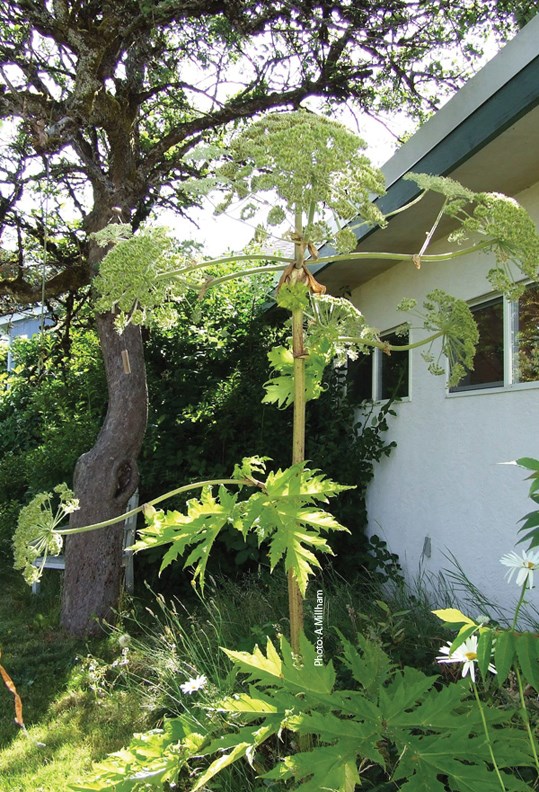There’s an invasive plant trying to take root on the Coast that produces a highly toxic sap that can cause burns, blisters and even blindness.
Giant hogweed (Heracleum mantegazzianum) is an aggressive invader that was first introduced to North America as a garden ornamental plant, according to a Coastal Invasive Species Committee (CISC) factsheet on the plant.
It closely resembles cow parsnip, which is a native plant, but giant hogweed grows much larger – up to six metres or more – while cow parsnip tops out at two metres.
Giant hogweed produces umbrella-like clusters of tiny white flowers. Each flower head can produce 100,000 seeds and those seeds can take root in the soil for up to 15 years after they have dropped.
The plant’s clear sap is highly dangerous and is easily transferred via tiny stem hairs and leaves.
Once transferred to the skin, it causes hypersensitivity to sunlight, which results in irritation and blistering that can be re-aggravated with exposure to sunlight for several years. If the sap makes contact with a person’s eyes it can cause blindness.
On the Sunshine Coast, there are currently seven sites where giant hogweed has been identified by the CISC.
Two sites are in Langdale, both off YMCA Road. Gibsons has two sites identified, one at the corner of Castle Road and King Road and one off Shoal Lookout.
In Davis Bay there’s a giant hogweed site off Parkway Drive, and in West Sechelt, there’s a patch that’s been identified off the forest service road at the end of Mason Road.
The final Sunshine Coast site identified by the CISC is in Pender Harbour off Keelson Road.
Sites are being monitored and treated by the appropriate government agencies. However, it may take several years to eradicate the toxic plant and the community should be aware of the invasive species.
“We advise that if members of the public come across a plant they suspect to be giant hogweed that they take a picture of it and email it to [email protected], or they can report the site, preferably with a picture again, via the Report-a-Weed application at www.coastalisc.com/report-a-weed,” said Kelsey Cullen, field and outreach assistant with CISC.
She noted that often reports of giant hogweed end up being harmless look-a-like plants, but it’s better to be safe than sorry.
To get rid of a giant hogweed plant you must wear protective clothing, gloves and eyewear and cut off the flowers to prevent seed formation. Plant roots must be severed eight to 12 cm below the soil surface, and all plant parts must be disposed of in strong garbage bags, not composted.
Immature plants can be kept at bay by covering them with black plastic or mowing regularly. Every three to five years, follow up treatment may be necessary.
Find out more about giant hogweed at www.coastalisc.com.



